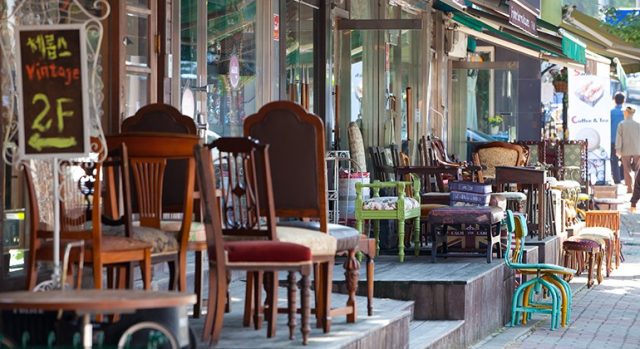Seoul, the vibrant capital of South Korea, is a city that seamlessly blends ancient traditions with modern innovations. While the bustling markets and towering skyscrapers may dominate the cityscape, there are hidden gems waiting to be discovered by adventurous travelers. One such treasure place is the Itaewon Antique Furniture Street, a unique destination that offers a nostalgic journey through time. In this article, we will explore the charm of this small street, learning its history, the diverse range of antique shops, and the immersive cultural experience it provides.
Unveiling Itaewon Antique Furniture Street’s Past
Established in the 1960s, Itaewon Antique Furniture Street holds a historical significance that goes beyond being just a marketplace. Initially catering to the U.S. military stationed in South Korea, the street has transformed into a living testament to Seoul’s rich cultural heritage. As you meander through its cobblestone streets, the antique shops narrate a story of cultural fusion, reflecting the diverse influences that have shaped Itaewon over the years.
Itaewon’s History and Cultural Diversity

According to Visit Korea, Itaewon Antique Furniture Street has been a part of Seoul’s landscape since the 1960s. Originally established as a hub for U.S. military personnel stationed in South Korea, it has evolved into a multifaceted reflection of Seoul’s rich history and cultural heritage. As you stroll along the old, cobblestone streets, you’ll encounter numerous antique shops, each exuding its unique charm. Over time, Itaewon has grown into a melting pot of various cultures, and the Antique Furniture Street beautifully showcases how these influences have shaped the area.
Navigating Itaewon’s Varied Neighborhoods
Starting at Hamilton Hotel, the alleys fan out in different directions, each offering a unique character. Head towards Namsan, and you’ll encounter upscale residential areas with mansions overlooking the Han River, hosting affluent families and celebrities. On the western side, a more working-class vibe prevails, showcasing a different facet of Itaewon. As you traverse the alleys from east to west, you’ll witness varying economic conditions and cultural nuances, encapsulating Itaewon’s international essence.
Exploring Itaewon’s Neighborhoods:
Itaewon is not just a simple district but a tapestry of diverse neighborhoods, each telling its unique story. Starting from the Hamilton Hotel and moving toward Namsan, the right side unfolds into upscale residential areas adorned with mansions, providing a picturesque view of the Han River. These neighborhoods are home to affluent families and celebrities, showcasing a more luxurious side of Itaewon.
On the western side of these upscale areas lies a typical working-class neighborhood, presenting a different vibe altogether. Walking from east to west through the alleys unveils distinct economic conditions and cultures, creating a fascinating tapestry of diversity. The fact that Itaewon is an international neighborhood is evident in the fluent English skills of real estate agents. These agents, dressed as if hosting foreign company executives, passionately extol the virtues and values of Itaewon.
While stories may include monthly rents approaching 10 thousands dollars, flyers advertising rooms with approximately 2 thousand dollars deposit and around 300 dollars monthly rent can be found in neighboring real estate office windows. This place is a mix of extremes, a testament to the diverse experiences one can encounter within the alleys of Itaewon.
A Glimpse into Itaewon’s Lively Past
Once heralded as Seoul’s liveliest district, Itaewon remains a vibrant entertainment district today. In the 1970s, U.S. Army soldiers fueled its economy, leaving traces of stores tailoring suits and selling souvenirs. The 1980 Seoul Olympics elevated Itaewon’s status further, and the area’s vitality remains, with stores specializing in large clothing and tailors thriving. The heyday of American liquor and cigarettes has faded, but the essence of excitement and cultural exchange remains etched in history.
Exploring Itaewon’s Lively Past
Itaewon’s lively past echoes through its alleys, each telling a tale of vibrant energy and cultural exchange. The 1970s saw the rise of entertainment and black markets in the alleys, with clubs catering to the U.S. military. Soldiers once bought souvenirs and wore suits tailored by stores that remain today.
The 1980 Seoul Olympics played a crucial role in elevating Itaewon’s status, solidifying its place as a vibrant and dynamic district. Stores that once sold souvenirs for returning soldiers have transformed into places offering antiques and interior items. While the scenes of American liquor and cigarettes have faded, the liveliness and diversity that defined Itaewon’s heyday are still palpable in its streets.
Itaewon’s evolution over the years reflects not only changes in the district itself but also mirrors broader societal shifts and international influences. Today, as you stroll through Itaewon Antique Furniture Street, you’re not just navigating through a marketplace but traversing a living history that continues to shape the district’s identity.
Itaewon Hallyu Wave
While Itaewon has long been known globally, it gained even more recognition through the Hallyu wave. Korean dramas like “Itaewon Class” transformed the district from a regular tourist spot into a cultural destination. In many ways, Itaewon is both the birthplace and primary beneficiary of the Hallyu wave, encapsulating a global and Korean essence in every corner.

Hallyu Wave and Itaewon’s Global Recognition:
Itaewon’s global recognition received a significant boost with the advent of the Hallyu wave. Korean dramas and pop culture, including the immensely popular “Itaewon Class,” brought international attention to this vibrant district. The global success of these cultural exports turned Itaewon from a regular tourist spot into a sought-after cultural destination.
In many ways, Itaewon has become a symbol of the Hallyu wave’s impact, attracting visitors from around the world who are eager to experience the unique blend of traditional Korean culture and modern global influences. The district’s ability to adapt to changing times while retaining its cultural roots makes it a dynamic and ever-evolving destination.
Itaewon’s connection to the Hallyu wave goes beyond its portrayal in popular media. The district’s atmosphere, diverse offerings, and vibrant energy contribute to its status as a hub for cultural exploration. As you navigate through Itaewon Antique Furniture Street, you’re not just stepping into a marketplace – you’re immersing yourself in a cultural phenomenon that has transcended borders.
Navigating to Itaewon Antique Village: A Simple Guide
For those eager to explore Itaewon Antique Village, navigating your way is simpler than it seems. Starting at Itaewon Station, take Exit 2, follow the signs, and let the main road guide you to vintage treasures. Spot landmarks, embrace the vibrant vibes, and soon you’ll find yourself at the entrance of Itaewon Antique Village, ready to immerse yourself in the world of vintage wonders.
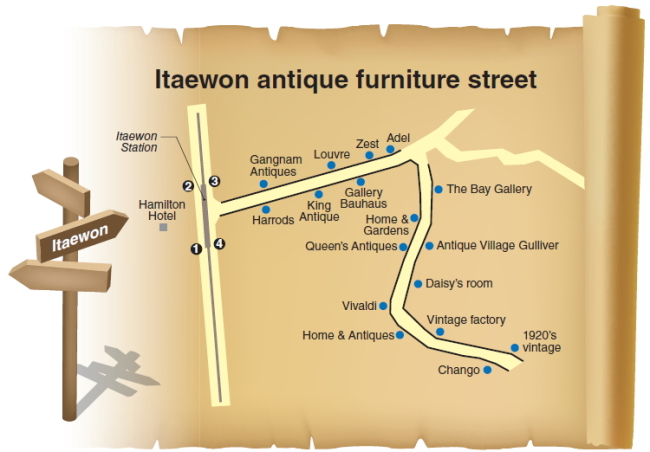
Going to Itaewon Antique Village might seem a tad confusing, but fear not – this guide will break it down into easy steps so you can enjoy your visit hassle-free.
Step 1: Starting Point – Itaewon Station
Your journey begins at Itaewon Station. Whether you’re arriving by subway or bus, this bustling hub is your starting point. Take a moment to soak in the surroundings – you’re in for a treat!
Step 2: Choose Your Exit
Once at Itaewon Station, find your way to Exit 2. Emerging from this exit puts you on the right track to reach the Antique Village. Signs are your friends here – follow the ones pointing to Itaewon Antique Village.
Step 3: Hitting the Streets
As you step out of the station, the streets of Itaewon will welcome you. Take a right turn and keep walking. The key is to stay on the main road – it’s like your yellow brick road leading to vintage treasures.
Step 4: Spotting the Landmarks
Keep your eyes peeled for landmarks that signal you’re on the right path. Look out for unique shops, cozy cafes, and intriguing art galleries. When you start seeing these, you’re in the heart of Itaewon Antique Village.
Step 5: Embrace the Vibes
As you stroll, soak in the vibes of this vibrant neighborhood. The Antique Village is not just a destination – it’s an experience. Don’t hesitate to explore the nooks and crannies; you might stumble upon hidden gems.
Step 6: Arriving at Itaewon Antique Village
Congratulations – you made it! Once you’ve enjoyed the walk and taken in the surroundings, you’ll find yourself at the entrance of Itaewon Antique Village. Now, all that’s left is to open the door and immerse yourself in the world of vintage wonders.
Exploring the Antique Shops
Walking along Itaewon Antique Furniture Street, you’ll be captivated by the varieties of antique shops lining the sidewalks. Each shop has its own distinct character, housing a treasure trove of items that range from exquisite furniture to vintage ornaments.
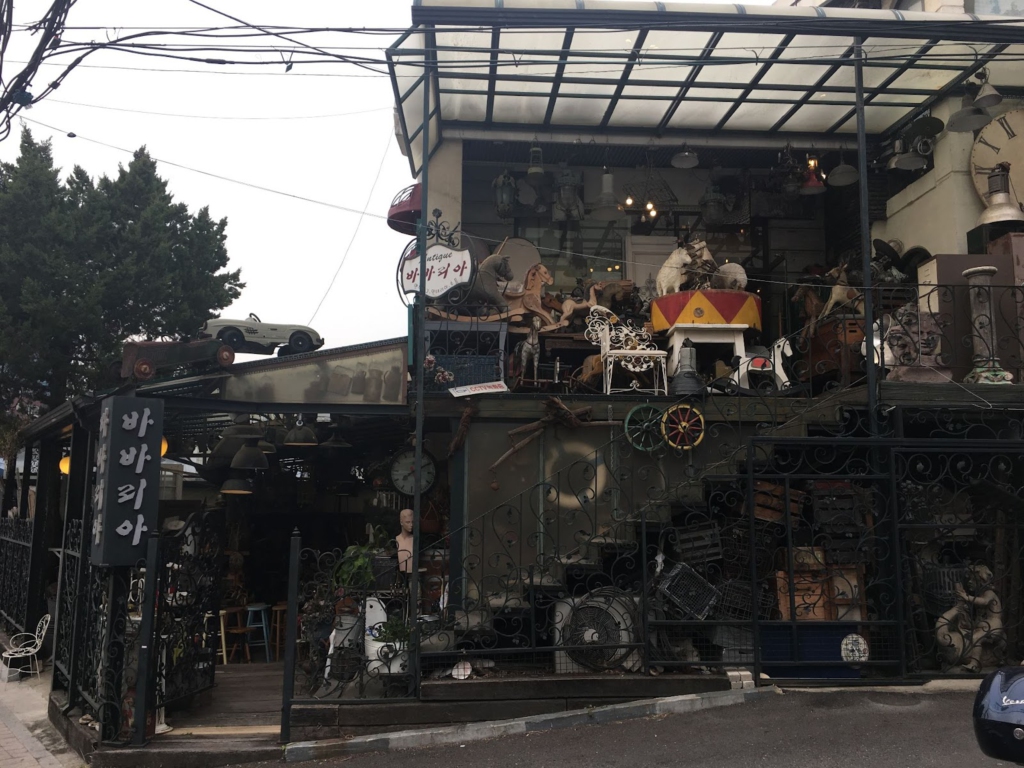
1. Gulliver21
A shop known for vintage furniture, “Gulliver21.com” offers a trip down memory lane. If you can understand and speak Korean, the staff can share the history behind each piece, adding a layer of depth to your shopping experience.
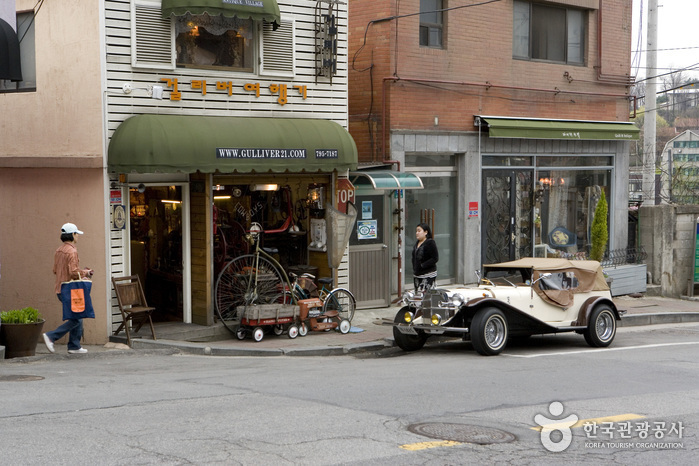
2. Alley Antique Village
Another gem along the street is “Alley Antique Village,” a shop that seamlessly blends antique and modern elements. Here, you can find unique pieces that have been repurposed or upcycled to suit contemporary tastes. It’s a perfect spot for those seeking a fusion of old-world charm and modern aesthetics.
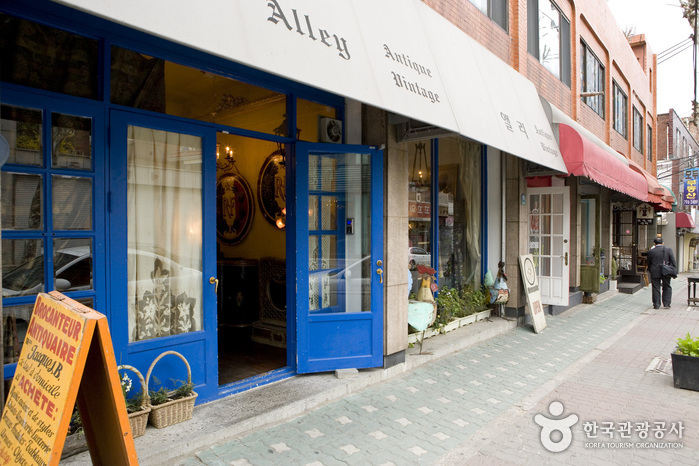
3. Chambre
“Chambre” doubles as a workshop and gallery. Watch craftsmen restore and recreate antique pieces, appreciating the artistry involved.
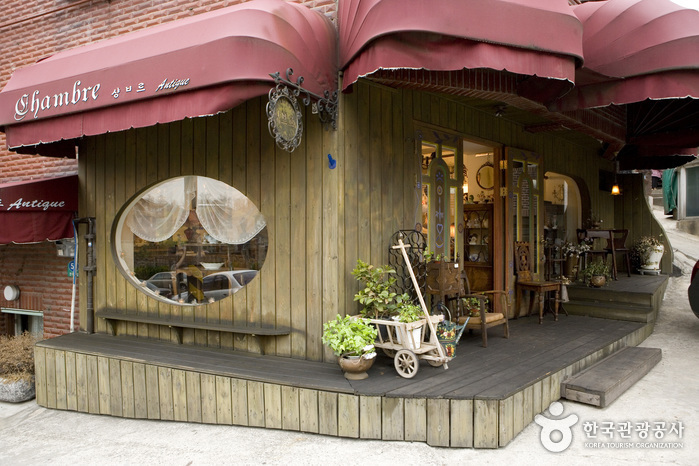
Immersive Cultural Experience:
Beyond the pure amazing pleasure of shopping for antique treasures, Itaewon Antique Furniture Street offers a cultural experience that goes beyond the ordinary. The street is adorned with charming cafes, art galleries, and small museums, creating a holistic environment for visitors.
1. Cafes with Character
Pause your exploration to indulge in the cozy ambiance of the cafes that dot the street. These establishments often feature vintage decor, creating a seamless extension of the antique theme. Enjoy a cup of aromatic Korean tea or coffee while surrounded by the warmth of carefully chosen antique furnishings.
2. Art Galleries and Exhibitions
Itaewon Antique Furniture Street is not just about shopping; it’s a hub for artistic expression. Numerous art galleries showcase works inspired by the rich cultural heritage of Korea. Keep an eye out for special exhibitions that may coincide with your visit, offering a deeper understanding of the intersection between tradition and contemporary art.
3. Interactive Workshops
Some shops along the street organize workshops where visitors can try their hand at traditional crafts such as pottery or calligraphy. These interactive sessions provide a hands-on experience, allowing you to connect with Korea’s cultural roots and create your own unique souvenir.
Local Cuisine and Hidden Gems
Exploring Itaewon Antique Furniture Street isn’t just about the antiques; it’s also an opportunity to savor the local flavors and discover hidden culinary gems.
Street Food Delights
Venture into the narrow alleys adjacent to the main street to discover hidden street food stalls offering a variety of delectable treats. From crispy Korean pancakes (bindaetteok) to savory dumplings (mandu), these local delights provide the perfect energy boost for your exploration.
Hidden Cafes
Amidst the antique shops, you’ll find charming cafes tucked away like secrets waiting to be discovered. These cafes often feature unique themes, from retro aesthetics to traditional Korean tea house vibes. Take a break, sip on a cup of aromatic tea, and absorb the ambiance that seamlessly blends the old and the new.
Most tourists do not know that Itaewon was the first to be designated as a special tourist zone in Seoul but Itaewon Antique Furniture Street stands as a testament to Seoul’s ability to preserve its rich cultural heritage while embracing the dynamism of the present. Whether you’re a seasoned antique collector, an art enthusiast, or simply a curious traveler, this hidden gem offers a unique experience that goes beyond the typical tourist attractions. Immerse yourself in the charm of the past era, explore the eclectic range of antique shops, and savor the cultural richness that defines Itaewon Antique Furniture Street – a true haven for those seeking a blend of history, art, and local flavor in the heart of Seoul.

